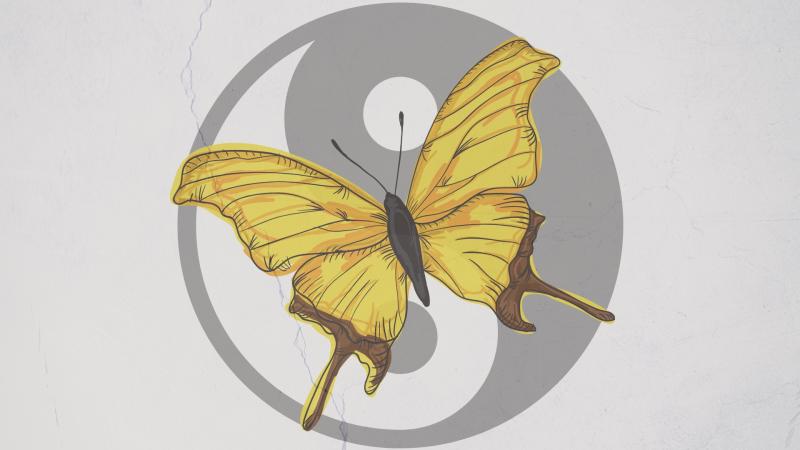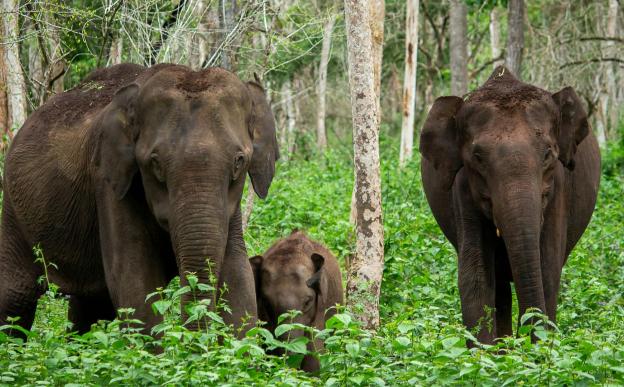
The lifecycle of organisms, from birth to death, revolves around two things—reproduction and the struggle to survive. It has to beat all odds, including outsmarting predators, for survival and propagation. Through the process of evolution, most organisms seem to have perfected this art. An incredible example is the caterpillar of the swallowtail butterflies, which changes its appearance and colour at various stages of its elaborate life cycle, to escape predators. But, how exactly do they do this? A new study by researchers at the National Centre for Biological Sciences (NCBS), Bengaluru, answers some of these questions. This study was published in the journal Ecology and Evolution.
Swallowtail butterflies are large, colourful butterflies belonging to the family Papilionidae. They are found on every continent except Antarctica and are famous for their dazzling colours and prominent tails on their hindwings. Because of their global distribution, the caterpillars use a wide variety of plants as food, in different habitats. The current study retraces the evolutionary history of these butterflies to understand how their interactions with plants and predators have led to the evolution of colour change through various developmental stages. These changes are also called ontogenic colour changes. Swallowtail butterflies are used as classic models to understand insect colouration since the time of Alfred Russel Wallace, who conceptualised natural selection.
The study shows that the ontogenic colour change depends on the complex interaction between the size and the level of motion associated with the different life stages of the caterpillar, the characteristics of its host plants, and its ancestry. The researchers quantitatively classified the various colours of the caterpillars into three types of colour defence strategies—aposematism, crypsis and masquerade. A wide variety of organisms use these strategies to escape from predators.

The reciprocal relationship between Ecology and Evolution
The researchers observed that swallowtail caterpillars at specific life stages opt for the most effective strategy depending on the risks they face and the resources the host plant provides. For instance, caterpillars feeding on toxic plants store these toxins in their bodies and use bright colours and striking patterns to advertise that they are unpalatable. Their predators, like reptiles, birds and small mammals, thus through trial and error, learn to avoid eating them.
If the host plants, on the other hand, are devoid of toxins, the caterpillars opt to resemble some inedible or aversive object, like bird droppings, when they are small in size. This technique is called masquerade. However, when they grow big and have to move more frequently to feed or to become a pupa, they switch to crypsis, where they blend in with their background. When these caterpillars become pupae, they all turn cryptic as a majority of predators detect prey using motion, and hence become less vulnerable.
“This is a very interesting study as it provides a rare example from the natural world of how the evolution of alternative variants of certain traits is driven by ecology”, says Prof. Amitabh Joshi, a renowned evolutionary biologist and a Professor at the Jawaharlal Nehru Centre for Advanced Scientific Research (JNCASR), Bengaluru. “Given that adaptive evolution is a historical process, it is always of interest to tease apart the relative role of ancestry, as a constraint to adaptive evolution, and ongoing selection imposed by ecological challenges such as predation or competition, in shaping the adaptations shown by different species or populations”, he adds.
The researchers of the study analysed many pictures of different developmental stages of the swallowtail and quantified their colours. This data was then used to retrace the evolutionary history of colour defences using an evolutionary tree of these butterflies to unravel why the colours change through the lifecycle. This analysis revealed some interesting outcomes; it linked the form and colour and of the caterpillars to their host plant, connecting behavioural and sensory ecology with life history theory.
The study found that the appearance of caterpillars was shaped primarily by their development, their predators and the host plants. The plants try to avoid being eaten up by the caterpillars and other herbivores; the caterpillars aim to grow fast and survive to adulthood; and the predators are always on the lookout for a juicy worm. The researchers found that the swallowtail lineages that stuck to their ancestral host plants, which are toxic and sparsely vegetated, had striking warning colouration. Those that frequently shifted host plants, used hues depending on the characteristics of the new host. Flashy warning colours were seen in caterpillars that fed on toxic sparsely vegetated plants, while those that ate non-toxic, densely-vegetated plants used camouflage to hide on their host plant and escape from predators.
This evolution of protective colouration in swallowtails elegantly illustrates the reciprocal yin yang-like relationship between ecology and evolution. Here, the evolutionary shifts from one family of host plants onto another altered the ecology of the swallowtail caterpillars, which then influenced the evolutionary trajectory of their colour defences. “Although several factors influencing animal colouration such as visual backgrounds, chemical nature of their diet, and lifestage vulnerability were individually identified, their interaction effects on the evolution of ontogenic shifts in colouration, which a wide variety of organisms exhibit, was largely missing. The study attempted to fill in those gaps”, explains Nikhil Gaitonde, a researcher at NCBS and the lead author of the study.
“Such detailed support for the overriding effect of ecology compared to ancestry has rarely been reported for a natural system”, remarks Prof. Joshi adding that the study is an excellent example of the power of the classic 'comparative method' in evolution, which is the principal way of deciding whether some trait variant is an adaptation in a set of naturally occurring species. “Experimental evolution in the lab can help one explore with exemplary rigour what "can" evolve, but only studies on natural populations of related species, like this study, can address the question of what "did" evolve as an adaptation to a specific ecological challenge”, he adds.
This study is also the first of its kind to quantify colour in caterpillars of a globally distributed family of butterflies. “In a tropical and biodiverse country like India, there are several excellent natural systems capable of providing novel insights in ecology and evolution using natural history observations and simple but well-designed experiments. But curiosity and a passion for the natural world is utmost necessary”, points out Gaitonde.
The authors stress that citizen science initiatives, like iNaturalist and ifoundbutterflies that curates valuable natural history information through pictures contributed by ordinary citizens, are treasure troves of biodiversity knowledge and played a vital role in this research.






